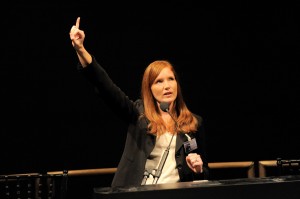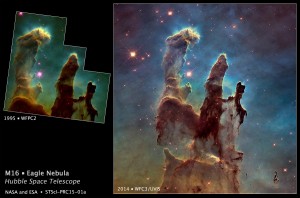When you hear NASA you probably think of the moon missions, the shuttle, space station, and the Hubble. With the Hubble’s 25th anniversary coming up, NASA has assembled an all-star panel for SXSWi. The panel, Hubble Touching the Universe, features many prominent scientists. Dr. Amber Straughn is a panelist, Chair of the Hubble 25th Anniversary Committee, and an astrophysicist.
Presentation at the National Air & Space Museum, with moderator Miles O’Brien; Sept. 2011.
“2015 marks 25 years in space, the launch anniversary is April 24th,” Straughn said. “We at NASA and ESA (European Space Agency) and our partners are excited to celebrate a year of Hubble. We kicked things off at the last week at the National Astronomical Society meeting, where NASA released a beautiful new image of M16, the pillars of creation.”
Straughn is joined on the panel by Dr. Jason Kalirai of the Space Telescope Science Institute, Alberto Conti from Northrop Grumman, and John Grunsfeld Associate Administrator of the Science Mission Directorate at NASA. Dr. Grunsfeld flew to Hubble three times on the third, fourth, and fifth Shuttle missions to the telescope. In addition to this he helped develop new gamma and X-ray detectors. His research pertains to binary pulsars, X-ray and gamma ray sources.
“John (Grunsfeld) leads all science at NASA, not just Astrophysics but Heliophysics, Earth Science, and Planetary Science,” Straugn said. “He also was an astronaut on several of the Hubble servicing missions.”
NASA is planning a year’s worth of events and content to be distributed all over the world. This will be done alongside its partner organization the European Space Agency (ESA). To see what else is going on they have collaborated to make a one stop site for the Hubble anniversary.
This celebration is not just about the past for the people at NASA and ESA, but also what the future holds.
“Alberto Conti will be talking about the future of astrophysics,” Straughn said. “Part of which is Hubble and part of which is the James Webb Space Telescope (JWST). Which, like Hubble, will undoubtedly transform our understanding of the universe. It will launch in 2018”
The JWST is the next big thing for astronomy. It is designed to pick up where Hubble will leave off. It will likely see the first dying stars in the history of the universe, directly observe planets outside our solar system, and since it sees only in the infrared it will pierce the dust of nebulae to see new stars being born.
This does not mean Hubble is done in 2018, far from it. Hubble and JWST will work in tandem. Hubble can see in the ultra violet, a unique capability. Therefore these two telescopes will compliment each other. This will amplify the information we will get far more than if they were working alone.
So with a lineup of experts and a history like nothing else humanity has built, Hubble has a good birthday celebration ahead of it at SXSWi. A celebration not just of the past difficulties and triumphs, but also a celebration of discoveries to come.
“Hubble is so much more than a scientific instrument,” Straughn said. “It’s a story, and the Hubble story is a very human story. Hubble overcame a whole lot of adversity early on in its mission, and it really demonstrated the great heights NASA is capable of. That’s thanks to the Hubble heroes; the scientist, technicians, researchers, and the astronauts who flew five servicing missions to it.”


